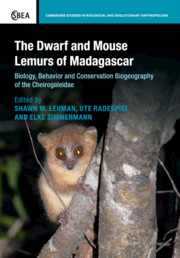 The Dwarf and Mouse Lemurs of Madagascar
The Dwarf and Mouse Lemurs of Madagascar from Part I - Cheirogaleidae: evolution, taxonomy, and genetics
Published online by Cambridge University Press: 05 March 2016
Introduction
The family Cheirogaleidae is arguably the most interesting group of primates alive today. Within this single clade, hypothesized to have originated approximately 25–30 Mya, we find the world's smallest living primate (genus Microcebus), one species that went “missing” for more than three decades (genus Allocebus), the only known obligate hibernator within the primates (genus Cheirogaleus), the only primate species that preys upon other members of its phylogenetic family (genus Mirza), and also, a taxonomic system that has exploded within the past two decades. This taxonomic explosion has been decidedly lopsided, however. Whereas the genus Allocebus has remained monotypic, containing the single species A. trichotis since its original description in 1875 (Günther 1875), the genus Microcebus (mouse lemurs) has gone from a two species system as recently as 1993 to one that that now contains more than 20 recognized species. This apparent skew in species-level diversity cries out for further exploration. Is it an artifact of organismal and geographic sampling bias, with certain species and ecosystems preferentially sampled, or is it based in biology, with some branches of the cheirogaleid tree (namely, the mouse lemurs) intrinsically more prone to evolutionary divergence? An exploration of these themes and questions is our goal in this chapter.
The first genus-level phylogeny of the cheirogaleid lemurs was published by Rumpler et al. (1994) and has remained virtually unchanged in the subsequent decades. Using karyotype data and restriction fragment analysis, the authors found strong support for the phylogeny illustrated in Figure 1.1. Notably, Rumpler and Albignac (1972) had long before discovered that the karyotype of Phaner (2n = 46) is quite distinct from that of the other four genera (2n = 66), leading those authors to propose a two-subfamily taxonomy of the Cheirogaleidae, the monotypic Phanerinae (including only the genus Phaner) and the Cheirogaleinae (comprising the four remaining genera). More recent molecular phylogenetic analyses have sampled more densely at the species level and have yielded fresh insights into interspecific relationships within the various genera, while leaving the “skeleton” of the phylogeny unchanged.
To save this book to your Kindle, first ensure [email protected] is added to your Approved Personal Document E-mail List under your Personal Document Settings on the Manage Your Content and Devices page of your Amazon account. Then enter the ‘name’ part of your Kindle email address below. Find out more about saving to your Kindle.
Note you can select to save to either the @free.kindle.com or @kindle.com variations. ‘@free.kindle.com’ emails are free but can only be saved to your device when it is connected to wi-fi. ‘@kindle.com’ emails can be delivered even when you are not connected to wi-fi, but note that service fees apply.
Find out more about the Kindle Personal Document Service.
To save content items to your account, please confirm that you agree to abide by our usage policies. If this is the first time you use this feature, you will be asked to authorise Cambridge Core to connect with your account. Find out more about saving content to Dropbox.
To save content items to your account, please confirm that you agree to abide by our usage policies. If this is the first time you use this feature, you will be asked to authorise Cambridge Core to connect with your account. Find out more about saving content to Google Drive.